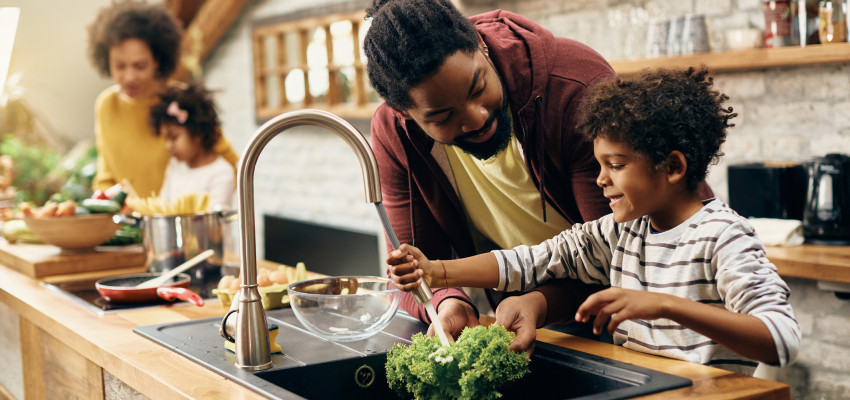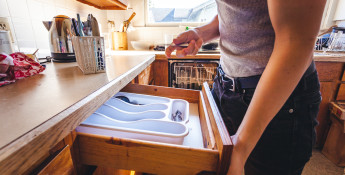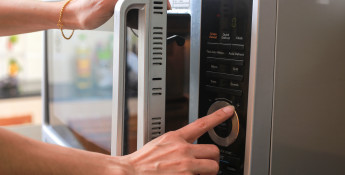By Chef Alli on January 18, 2022
Foods We Should be Washing and Foods We Shouldn’t

Do you sometimes wonder which foods need rinsed as part of their prep and which foods shouldn’t be? There’s a right way and a wrong way and this guide will help.
Foods to Be Washed
Fruits with Inedible Skins
We aren’t going to eat inedible skins of fruits and veggies, so why is there a need to wash them?
The point of possible contamination of the inside flesh comes when we take a sharp knife and cut into said fruits and veggies.
Yep, the moment you slice a big chunk of watermelon or cut an orange in half you may be transferring bacteria from the exterior to the interior via the knife blade.
This is also especially important if you enjoy adding slices of lemon to ice water. Wash the rind well before slicing so potential bacteria isn’t seeping into your beverage.
A safe and inexpensive produce wash can be made by combining 1/2 cup white vinegar with 2 cups of water in a spray bottle; shake well. Place a colander into the sink and add your produce; spray with the prepared produce wash, then let the fruits or veggies rest for a few minutes before rinsing.
Canned Beverages and Foods
Canned beverages and foods make their way through a maze of trucks, warehouses and distribution centers before landing at the grocer.
As these items travel, they pick up grime and grit along the way, likely nothing we would ever want close to our mouths or in any foods.
To be safe, give all cans a quick rinse, or a good wipe down with a clean, damp cloth before consuming.
Celery
Because celery has narrow grooves that run the length of every rib, dirt can accumulate in the ridges. A quick rinse under cool running water solves the problem.
Canned Beans
When beans are commercially canned, they are packed in a solution of water and salt.
Over time, the water tends to absorb starch from the beans, turning it starchy and thick; this liquid can affect the texture and taste of the recipe you add the beans to.
Draining and rinsing canned beans is also key for helping remove sodium.
Potatoes
Because potatoes (all root vegetables, actually) are grown completely underground, they are covered by dirt right from the get-go.
Many people reason that if they are peeling the potatoes and won’t be eating the skin, there’s no reason to rinse them first. Wrong!
As you peel, any bacteria on the surface of the skin tends to get caught in the peeler blade, transferring it right to the flesh of the potato.
It’s actually a great idea to rinse all root vegetables before AND after peeling.
Clams and Mussels
To remove the sand and grit that comes with fresh clams and mussels, begin by rinsing them off under running cold water.
Next, submerge the shellfish in a bowl of cold water, placing the bowl into the fridge for an hour.
Once you gently lift the clams or mussels from the water, you may be surprised to see how much sediment has removed itself and settled to the bottom of the bowl.
Cruciferous Vegetables
Cauliflower, broccoli and Brussels sprouts can always benefit from a good soak.
Since cruciferous veggies have many nooks and crannies where dirt likes to hide; soaking them ensures they are clean and ready to be cooked or eaten raw.
Soak cruciferous vegetables for five minutes to allow the water time to penetrate. Then rinse well under running water.
Grains
Grains such as barley, quinoa, farro and millet should be rinsed before cooking to remove any dirt and debris.
Rinsing is also a very important step for those who suffer from celiac disease since the grains could have been grown close to wheat, barley or rye (which contain gluten, the enemy of those who are celiac) and are now considered to be contaminated.
It is also easy for cross-contamination to occur during processing and packaging.
Rice
If you enjoy rice that is very fluffy in texture, be sure to give it a good rinse in cool water before cooking.
Because rinsing removes the starchy powder on the exterior of the rice, this step also ensures your rice won’t be as sticky once it’s cooked, making it easier to handle.
Berries
It’s definitely tempting to break open that container of berries for a quick, healthy snack on the way home from the grocer.
However, because there could be bacteria on the surface of the fruit, do rinse all berries first. This is especially so for blackberries and raspberries since they have bumpy exteriors that can especially trap bacteria.
Because berries don’t particularly take well to water, either rinse just before eating or place folded paper towels into the bottom of the storage bowl to help wick away moisture.
Leeks
Leeks tend to be grown in very sandy soil. That sand, of course, always seems to find its way inside, making itself right at home between every layer of a leek.
The best way to remove the grit is to first slice off the root at the end of the bulb. Next, cut the leek horizontally in half, placing each half bulb-end first into a large bowl of cool water.
Let the leeks soak for an hour or so, allowing the sand to release itself out of the layers, down into the bottom of the bowl.
Head Lettuce
Because lettuce won’t be cooked, it’s especially important to rinse it well, removing harmful bacteria.
Lettuce is a master at hiding dirt and potential bacteria in all its nooks and crannies, and in some cases, it can even be hiding tiny bugs.
So even if your lettuce is grown right in your very own backyard, it’s important to wash it before you make that favorite mixed greens salad.
Foods Not to Be Washed
Mushrooms
If you’re thinking that’s dirt clinging to your button or portobello mushrooms, think again. That is actually peat moss, and it’s all pasteurized.
The best way to clean mushrooms is NOT to rinse them at all. Instead, use a soft, damp cloth to brush off the exterior of the mushrooms.
Eggs
Before eggs are placed into cartons, they go through a special machine-washing process that cleans the exterior of the eggs with soap and water.
This process sanitizes the outside of the eggshells removing any salmonella bacteria that could possibly be present.
If you’re eating farm-raised eggs or eggs from backyard chickens, do be sure to thoroughly wash them before cracking them open.
Poultry and Fish
Many home cooks are surprised to learn that rinsing fish and poultry increases our chances of becoming sick from bacteria.
Rinsing fish and poultry in the sink can easily cause the spread of germs all over the kitchen because of dripping and splashing on the surrounding sink area and countertops.
The best way to kill bacteria on raw fish and poultry is to cook it to the recommended temperature for food safety--165 degrees F internally for chicken and 145 degrees F for fish.
Packaged Greens
Nearly all bagged and boxed greens have been pre-washed and are ready to eat as is. Check the labeling to verify this and to save you the time and hassle of washing again when you don’t need to.
Pasta
While we don’t want dust on the grains we cook, pasta is a completely different story. The extra starch is what helps sauce stick to pasta instead of sliding off.




